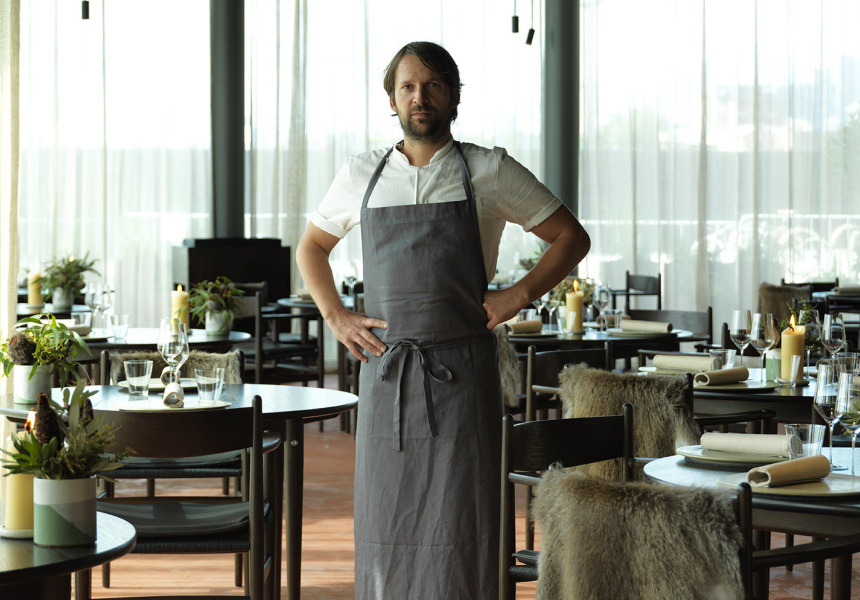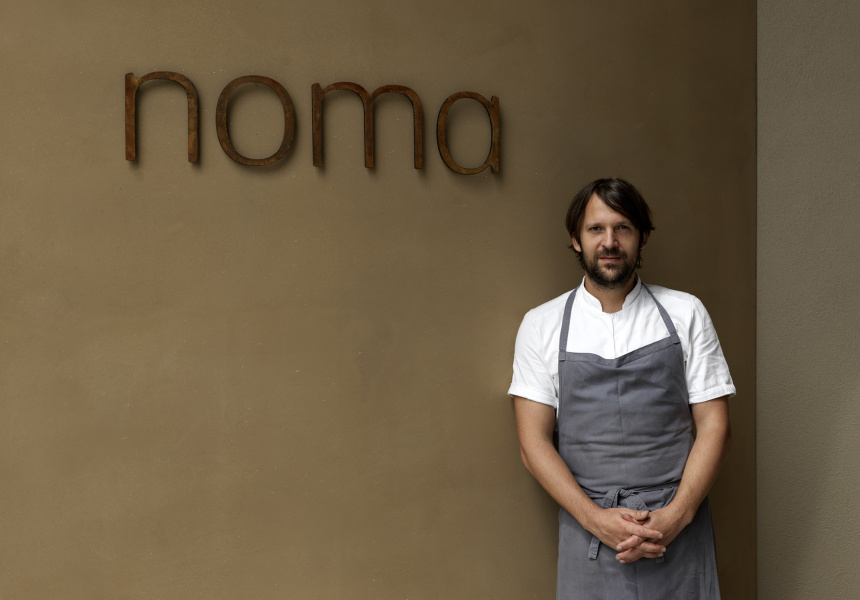Before you even consider dining at Noma Australia there are a few questions you need to ask yourself. Am I the kind of person who will spend $500 on one meal? Do I even have $500? What do I have to do to get into the third-best restaurant in the world? Next, you have to prepare yourself for the bittersweet experience of crossing something off your bucket list. And prepare yourself for the possibility you may not like it.
Noma is here for 10 weeks in total – transplanted from Copenhagen. It sold out in minutes. A number of prominent chefs have spent time in the kitchen or on the floor at Noma Copenhagen and have returned with a desire to forage, and with a penchant for natural wine.
The day arrives. I walk toward the restaurant, trying to keep my cool. I’m nervous because I’m about to have one of the best culinary experiences of my life. A beige curtain behind a curved glass wall conceals the restaurant – saving the interiors for a grand reveal. Plants, in red-brown cylinders of varying heights, line the side of the building. Some look familiar and edible, some are unrecognisable. All provide a clue to what’s inside; an homage to Australia’s flora and coastlines.
We think you might like Access. For $12 a month, join our membership program to stay in the know.
SIGN UPThe first thing I see when I step into the restaurant is a wall of smiling faces, greeting me in chorus. It’s disarmingly charming. The staff is exceedingly pleasant, chatty, patient and real – happy to go off topic, talk about their time here. They’re receptive when my dining partner tries to teach them dirty Australian slang. When asked what he looks for in his staff, René Redzepi replies, “Personality, curiosity and spirit.”
The casual manner of the staff belies a deep knowledge and passion for their craft. They are perfectly attentive, efficient and gracious. They are a huge part of what makes Noma great. They are there not to make you feel like you are eating at one of the best restaurants in the world, but to help you enjoy it.
I’m seated, consulted and have a drink in front of me in what seems like one smooth motion. Every diner has to check in with a member of the waitstaff for permission to go to the bathroom so it doesn’t interrupt the flow of your meal (which means you may have to wait until a course has arrived).
The third course is porridge of golden and desert oak wattleseed with saltbush, served by Redzepi himself. As he places it on the table he says, “Australia has a true wilderness. At home, we are known for being wild, serving wild food. But it is a contained wilderness. We don’t have a wildness like this.” He adds later, “It’s more of a realisation on my behalf, seeing the ingredients here and trying to decode them. It definitely takes more work to make them familiar and accessible to the modern palate. A serving that has a bit of that punch to it, that the bush offers.”
The 12 courses aren’t all delicious or easy to eat – they are variously salty, briny, sour or earthy. As Redzepi says, they have punch. The produce speaks to the harsh landscape it comes from. Redzepi was stunned by our country, enchanted, and this is what he has chosen to show us. With a plate of fresh muntries (native cranberries), lemon aspen and lillipillies coated with a powder of Kakadu plums, he answers the question, “What is the essence of pre-colonial Australian food?”
The space, which will be inherited by Bentley reflects the Australian landscape – red, packed-earth floors, dark wooden chairs and tables (that will be sold once the pop-up has finished), simple white candles, midnight-blue walls and stone-grey plates. The waiters wear collarless white shirts, and there are wallaby skins on the backs of some chairs (a by-product that is usually discarded).
Redzepi’s approach to the exotic produce he found in Australia is fearlessly original. Who else would think to first steam, then flatten and crumb abalone, and serve it with various plants foraged from near a beach? To pick macadamia nuts unripe (which means they have to be harvested individually), slice them wafer thin and pair them with spanner crab consommé and, brilliantly, rose oil? The oil is more earthy than floral, heightened by the salty broth and the green, mild flavour of the nuts.
“First, we wanted to find a way to actually make it tender and delicious, so we spent quite a bit of time trying to figure that out before we ventured into actual ideas,” says Redzepi of the abalone. “I think the idea of a schnitzel came very fast. I can’t remember how it actually came up – putting the different ingredients together was the merging of two ideas that became one,” says Redzepi.
Everything comes together in the spanner-crab dish. In the wild, these crabs are huge, snowy-white creatures living out of reach of sunlight off the west coast near Albany. At Noma, they are served as an indulgent bowl of meat, mixed with egg yolk and just a few drops of kangaroo garum that makes the sauce rich with umami, enhancing the pure sweetness of the crab.
Noma offers juice pairings, and has done so for seven or eight years. “I myself am not a very big alcohol drinker,” explains Redzepi. It’s becoming more common in fine-dining establishments, a boon for anyone who doesn’t want to drink wine. Rather than completing a dish, it extends it. Juice flavours include bergamot kombucha with native lime, but the best is smoked pepper and smoked red berry, which tastes almost like a gazpacho. It is served with sea urchin and tomato dried with pepper berries. The tomatoes are skinless and lightly dehydrated, soft but whole with an intensified flavour. Drinking the juice with it is like looking at a painting, then walking to the back of the room and looking at it again.
The experience of eating at Noma is not for everyone – most people want to eat something delicious, not food that challenges and teaches them new things. And why shouldn’t they? So what then, does a diner take away from Noma? Why should we be eating native produce if it requires you work to appreciate it, and is similarly difficult to procure and prepare?
Firstly, there’s so much of it the vast majority of us have never tasted: Noma’s menu was the tip of an iceberg. “There are about 30 varieties of Kakadu plum trees,” writes John Newton in The Oldest Food in Australia. “How many have we tried? Hardly any. There's so much still to be explored.”How exciting is that? There’s hundreds or maybe thousands of plants and animals that don’t grow or live anywhere else in the world. More than any other restaurant, Noma will expose us to their culinary possibilities.
No less interestingly, it’s good for you. The Oldest Food in Australia addresses a study on the nutritional value of native produce. Scientists found a type of Kakadu plum that is the highest naturally occurring source of antioxidants on Earth. The study suggests this is because the plant need to deal with the extreme stress of the desert, and implies there’s much more research to be done.
Redzepi isn’t the first chef to focus on native produce in Australia. It didn’t take a Dane to show us to ourselves. As Newton points out, pioneering restaurateurs used native foods in the ’80s, and many have since. Redzepi had the time and support to explore Australia deeply, with the benefit of seeing it for the first time.
The best part of eating in Australia is trying different cuisines made with locally grown produce. “It’s impossible to characterise Australian cuisine right now,” says Redzepi. “It’s very much based around big-city offerings: the typical Western fare, European-styled fine-dining restaurants, Italian food, Chinese, Thai. I’m not sure how you would characterise that besides “modern urban.” But I definitely think that Australia offers some of the most hard-working, creatively inspiring cooks that I know of.” Redzepi, inspired by us, inspires us.



